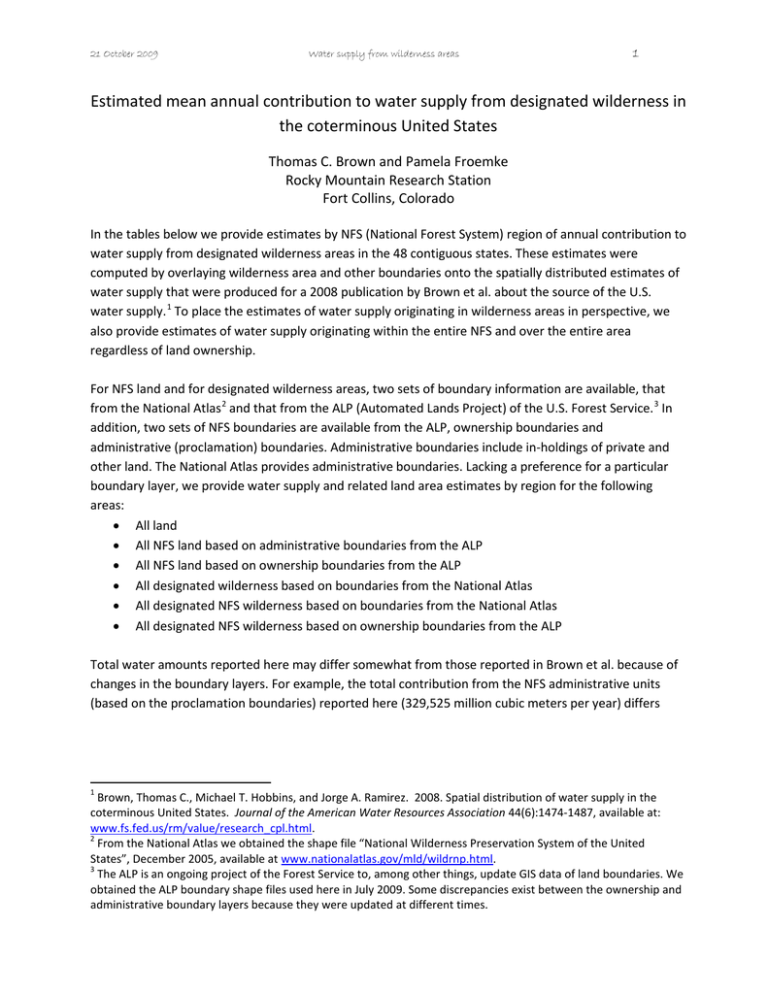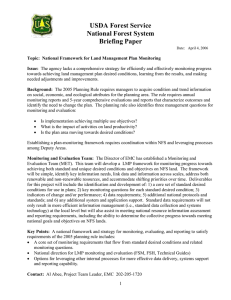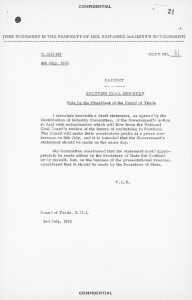Estimated mean annual contribution to water supply from designated wilderness... the coterminous United States
advertisement

21 October 2009 Water supply from wilderness areas 1 Estimated mean annual contribution to water supply from designated wilderness in the coterminous United States Thomas C. Brown and Pamela Froemke Rocky Mountain Research Station Fort Collins, Colorado In the tables below we provide estimates by NFS (National Forest System) region of annual contribution to water supply from designated wilderness areas in the 48 contiguous states. These estimates were computed by overlaying wilderness area and other boundaries onto the spatially distributed estimates of water supply that were produced for a 2008 publication by Brown et al. about the source of the U.S. water supply. 1 To place the estimates of water supply originating in wilderness areas in perspective, we also provide estimates of water supply originating within the entire NFS and over the entire area regardless of land ownership. For NFS land and for designated wilderness areas, two sets of boundary information are available, that from the National Atlas 2 and that from the ALP (Automated Lands Project) of the U.S. Forest Service. 3 In addition, two sets of NFS boundaries are available from the ALP, ownership boundaries and administrative (proclamation) boundaries. Administrative boundaries include in-holdings of private and other land. The National Atlas provides administrative boundaries. Lacking a preference for a particular boundary layer, we provide water supply and related land area estimates by region for the following areas: · All land · All NFS land based on administrative boundaries from the ALP · All NFS land based on ownership boundaries from the ALP · All designated wilderness based on boundaries from the National Atlas · All designated NFS wilderness based on boundaries from the National Atlas · All designated NFS wilderness based on ownership boundaries from the ALP Total water amounts reported here may differ somewhat from those reported in Brown et al. because of changes in the boundary layers. For example, the total contribution from the NFS administrative units (based on the proclamation boundaries) reported here (329,525 million cubic meters per year) differs 1 Brown, Thomas C., Michael T. Hobbins, and Jorge A. Ramirez. 2008. Spatial distribution of water supply in the coterminous United States. Journal of the American Water Resources Association 44(6):1474-1487, available at: www.fs.fed.us/rm/value/research_cpl.html. 2 From the National Atlas we obtained the shape file “National Wilderness Preservation System of the United States”, December 2005, available at www.nationalatlas.gov/mld/wildrnp.html. 3 The ALP is an ongoing project of the Forest Service to, among other things, update GIS data of land boundaries. We obtained the ALP boundary shape files used here in July 2009. Some discrepancies exist between the ownership and administrative boundary layers because they were updated at different times. 21 October 2009 Water supply from wilderness areas 2 from that reported in Brown et al. (325,691 Mm3/yr) because of recent changes (both additions and corrections) to the ALP NFS boundary layer. 4 Table 1 provides estimates of mean annual contribution to water supply for the eight NFS regions in the coterminous U.S. based on administrative (proclamation) boundaries available from the National Atlas and the ALP. Table 2 presents similar estimates based on ownership boundaries. Table 3 presents the respective land areas. Focusing on the administrative boundaries (Table 1), we see that 4.9% of the water supply of the 48 states originates on designated wilderness areas in an average year, and that 3.6% originates on wilderness areas in the NFS. About 18.6% of the total water supply originates on NFS lands, and 19.5% of that comes from wilderness areas. 5 The contribution of the NFS lands and NFS wilderness is most notable in Region 1 (76% and 18.3%, respectively), whereas the contribution of wilderness areas in general is most notable in Region 6 (18.7%). The amount of water supply originating in a given wilderness area or other land area depends on the size of the area and the depth of the contribution to water supply per unit of area. Depth per unit area varies greatly across the landscape, ranging from essentially zero in the driest desert areas to over 1.5 meters per year in the wettest areas of the Pacific Northwest. Compared with the average depth for the entire coterminous U.S., of 229 mm/yr, the NFS contributes an average of 385 mm/yr, wilderness areas in general contribute an average of 453 mm/yr, and NFS wilderness areas contribute an average of 545 mm/yr (Table 4). Looked at another way, wilderness areas in general occupy only 2.5% of the land base (Table 3) but contribute 4.9% of the water supply of the coterminous U.S. (Table 1). The contribution of wilderness areas is most notable in Region 6 (Table 4). Notice that the contribution to water supply from NFS lands is greater if computed using administrative boundaries than it is if computed using ownership boundaries (which is expected given that administrative boundaries include inholdings), but that the contribution from NFS wilderness lands is greater if computed using ownership boundaries than using administrative boundaries. This unexpected result occurs because the ownership boundary data are more current than the administrative boundary data. Because recent additions to the wilderness system are included in the ownership boundary data but not in the administrative boundary data, the contribution to water supply from wilderness areas computed using the administrative boundary data is an under-estimate. A full explanation of the methodology used to estimate mean annual water supply is included in Brown et al. (2008). Here we briefly summarize some of the key points and qualifications: · · 4 These estimates of mean annual contribution to water supply are based on data for 1953-94, which may not represent current or future hydrologic conditions. There is considerable year-to-year variation about the means reported here, variation that is not at all evident in the means. For the analysis we converted the ALP and National Atlas polygons and the 5 km water supply grid to congruent 250 m grids. 5 When the NFS area is restricted to the land actually owned, wilderness areas are estimated to contribute 24.1% of the total NFS contribution to the water supply of the 48 states (Table 2). 21 October 2009 · · · · Water supply from wilderness areas 3 “Water supply” as used here was computed as precipitation minus natural evapotranspiration. (Evaporation occurs as water evaporates from soil and vegetation surfaces. Transpiration occurs as vegetation gives up water vapor to the atmosphere through small openings called stomata, principally in the process of photosynthesis.) Estimating water supply in this way makes the assumption that water entering the soil that is not evaporated or transpired eventually becomes available for use either by naturally returning to the surface at some point downstream or by being pumped to the surface. Evapotranspiration was estimated using computer models that rely on data from weather stations (for variables such as solar radiation, wind speed, and humidity). Values of weather variables for areas between stations were estimated by spatial interpolation. In addition, precipitation for areas between weather stations was estimated. Weather stations are particularly sparse in mountainous areas of the West. This estimation between stations introduces errors in the estimates of water supply. Such errors are more likely when applying the model to small areas, which may contain few or no weather stations within the boundary. In selected watersheds—relatively pristine watersheds that have stream gages at the outlet—the models were tested for accuracy and were further refined by comparing predicted water supply to measured streamflow. Natural discharge data were lacking for some areas of the U.S., especially in drier portions of the West, which hampered testing and refinement and may introduce errors. The estimates of water supply for wilderness area could not be tested for accuracy because of the lack of strategically located stream gages. 21 October 2009 4 Water supply from wilderness areas Table 1. Mean annual contribution to water supply based on administrative boundaries 3 Region Water volume (million m /yr) All area 1 2 3 4 5 6 8 9 Total NFS All W b Percent of total (all area) volume originating in: NFS W NFS All W NFS W 51,772 20,460 5,077 36,804 42,142 90,912 51,311 31,048 12,489 7,270 995 8,429 13,371 39,518 2,556 1,870 12,462 7,185 953 8,385 8,373 23,471 1,813 1,770 76.0 28.6 49.8 55.4 45.3 43.1 7.7 5.3 18.3 10.2 9.8 12.7 14.4 18.7 0.4 0.3 18.3 10.0 9.4 12.6 9.0 11.1 0.3 0.3 24.1 35.1 18.8 22.8 19.9 25.8 3.5 5.7 1,767,613 329,525 86,499 64,411 18.6 4.9 3.6 19.5 Percent of water supply originating on NFS land that originates in wilderness areas b W = wilderness Table 2. Mean annual contribution to water supply based on ownership boundaries 3 Water volume (million m /yr) All area 1 2 3 4 5 6 8 9 Total a b NFS W 68,124 71,614 10,195 66,464 93,047 210,931 666,341 580,898 a Region a % of NFS 68,124 71,614 10,195 66,464 93,047 210,931 666,341 580,898 1,767,613 NFS 48,119 19,015 4,810 34,622 35,863 83,855 27,747 17,862 271,892 NFS W % of total volume originating in: b 12,815 7,119 939 8,638 8,981 23,345 1,803 1,872 65,511 NFS 70.6 26.6 47.2 52.1 38.5 39.8 4.2 3.1 15.4 NFS W 18.8 9.9 9.2 13.0 9.7 11.1 0.3 0.3 3.7 a % of NFS NFS W 26.6 37.4 19.5 24.9 25.0 27.8 6.5 10.5 24.1 Percent of water supply originating on NFS land that originates in wilderness areas in the NFS W = wilderness 21 October 2009 5 Water supply from wilderness areas Table 3. Land area (km2) Region 1 2 3 4 5 6 8 9 Total All area 630,724 1,066,056 608,291 714,274 392,073 414,817 2,185,002 1,697,191 7,708,427 a NFS NFS All W NFS W NFS W ALP b Admin ALP c Owner National Atlas National Atlas ALP Owner 119,373 112,593 93,632 137,950 95,274 110,977 100,349 85,213 855,361 101,917 88,178 81,906 128,587 81,556 99,933 53,906 48,259 684,241 20,239 20,416 24,970 27,180 55,571 27,180 8,862 6,634 191,052 19,783 19,176 11,101 21,847 17,722 19,146 2,953 6,395 118,123 20,404 19,161 10,939 23,063 18,206 19,068 2,905 5,366 119,113 a W = wilderness Admin = administrative (proclamation) boundaries c Owner = ownership boundaries b Table 4. Average depth of contribution to water supply (mm/yr) Region 1 2 3 4 5 6 8 9 All a All area 108 67 17 93 237 508 305 342 229 NFS ALP b Admin 434 182 54 267 442 819 511 364 385 NFS ALP c Owner All W National Atlas 472 216 59 269 440 839 515 370 397 W = wilderness Admin = administrative (proclamation) boundaries c Owner = ownership boundaries b 617 356 40 310 241 1,454 288 282 453 NFS W National Atlas 630 375 86 384 472 1,226 614 277 545 a NFS W ALP Owner 628 372 86 375 493 1,224 621 349 550




